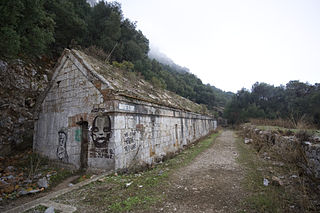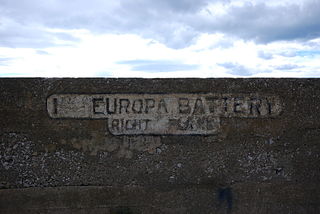| Victoria Battery | |
|---|---|
| Part of Fortifications of Gibraltar | |
| Gibraltar | |
| Coordinates | 36°07′56″N5°21′08″W / 36.132171°N 5.352193°W |
| Type | Artillery Battery |
| Site information | |
| Owner | Ministry of Defence |
| Site history | |
| Built | 1883 |
Victoria Battery (one of two identically-named batteries named after Queen Victoria) was an artillery battery in the British Overseas Territory of Gibraltar. It was built in the 1840s on top of the earlier Princess of Wales Batteries following a report by Major-General Sir John Thomas Jones on Gibraltar's defences. The battery was located on the west side of Gibraltar and was one of a number of "retired" batteries in the territory, constructed to improve the coastal defences between Europa Point and the town. [1]

Victoria was Queen of the United Kingdom of Great Britain and Ireland from 20 June 1837 until her death. On 1 May 1876, she adopted the additional title of Empress of India.

In military organizations, an artillery battery is a unit of artillery, mortars, rocket artillery, multiple rocket launchers, surface to surface missiles, ballistic missiles, cruise missiles etc., so grouped to facilitate better battlefield communication and command and control, as well as to provide dispersion for its constituent gunnery crews and their systems. The term is also used in a naval context to describe groups of guns on warships.

The British Overseas Territories (BOTs) or United Kingdom Overseas Territories (UKOTs) are 14 territories under the jurisdiction and sovereignty of the United Kingdom. They are remnants of the British Empire that have not been granted independence or have voted to remain British territories. These territories do not form part of the United Kingdom and, with the exception of Gibraltar, are not part of the European Union. Most of the permanently inhabited territories are internally self-governing, with the UK retaining responsibility for defence and foreign relations. Three are inhabited only by a transitory population of military or scientific personnel. They all share the British monarch as head of state.
The battery was completed by 1843 and was nicknamed "Snake in the Grass Battery" due to its irregular undulating shape, measuring about 200 yards (180 m) long. It mounted fifteen 32-pdr. guns in 1850, seven of which were replaced in 1863 by 68-pdrs. In 1868 Colonel W.F.D. Jervois wrote a report into the defences of Gibraltar which recommended installing larger rifled muzzle loader (RML) guns. Two 9-inch RMLs were installed in the south flank with iron casemates providing protection. This reduced the space available for the other guns to seven emplacements, of which three were occupied by 80-pdr. RMLs by 1888. The 9-inch RMLs were later replaced by 10-inch RMLs but all of the 80-pdrs. were removed in 1892, followed by the 10-inch guns in 1900. [1]

A rifled muzzle loader (RML) is a type of large artillery piece invented in the mid-19th century. In contrast to smooth bore cannon which preceded it, the rifling of the gun barrel allowed much greater accuracy and penetration as the spin induced to the shell gave it directional stability. Typical guns weighed 18 tonnes with 10-inch-diameter bores, and were installed in forts and ships.
In 1878 a new battery, also called Victoria Battery, was constructed on the right flank of the earlier battery to house a 100 ton gun. It was completed in 1883 but fell into disuse within only five years, by which time the gun was already obsolete. [2]

Victoria Battery was an artillery battery in the British Overseas Territory of Gibraltar. It was notable for being one of the two batteries in Gibraltar to mount a 100-ton gun.











